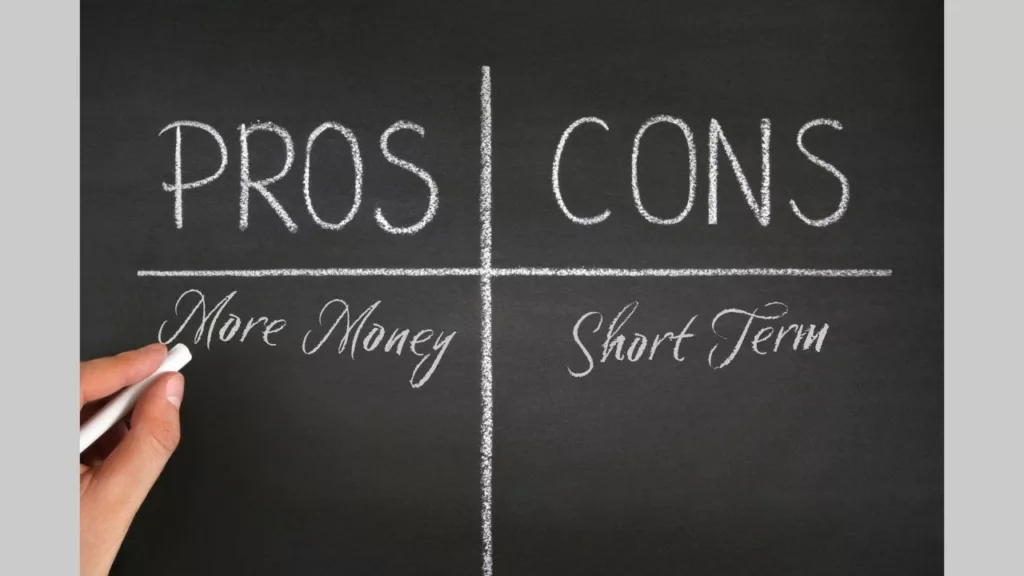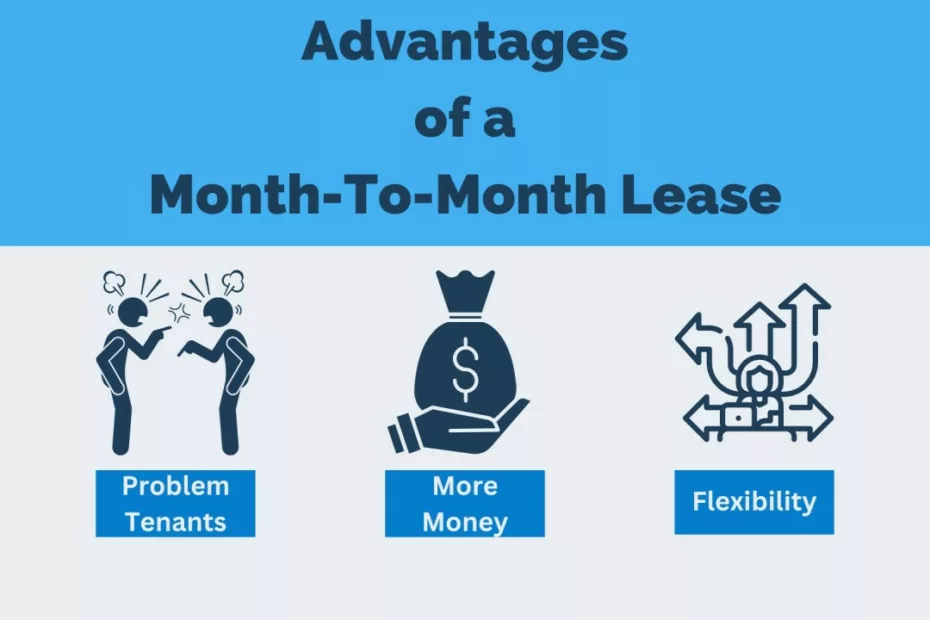This article will examine month-to-month leases and help you decide how much more these tenants should be charged. I have been managing rental properties for over 16 years and have tried many strategies for managing month-to-month tenants. I have discovered what works and doesn’t and am here to share this knowledge. How much more should you charge for a month-to-month lease?
In most cases, add about 10% to the monthly rent. If you are sure they will stay less than three months, you should charge about 50% of the monthly rent. However, don’t add a charge if they have no definite end date and will likely stay as if they had a regular lease.
It’s prudent for the landlord to hold out for a long-term tenant or to ask for more rent from the short-term tenant. The property will likely have normal wear-and-tear, even over the short term, that the landlord must address before getting another tenant. On top of that, the property will likely have at least one vacant month before the next tenant can be found. Good tenants who stay long-term can help minimize these costs.
The difficult question is how much more rent should be charged for a short-term lease, and that number varies based on the circumstance. After reading this article, you will know exactly how much more you should trust in nearly every situation.
Deciding the Amount of the Rent Increase

Another way to think of this is that a long-term lease comes with a bulk purchase discount, meaning that the tenant is buying many months of housing, and the landlord is receiving many months of rent. As a result, it’s a good idea to offer the tenant a discount for this large purchase. If your standard lease is an entire year, your rental prices already include this discount, and you would be removing it for tenants buying fewer months of occupancy.
Short Term Rentals are Costly
There are high turnover costs when a tenant leaves the property. Some damages can be charged to the tenant, and security deposits can be withheld, but the landlord must handle normal wear-and-tear at their own cost. These turnover costs should happen rarely, but with frequent new tenants, they will happen more often, and the landlord needs to recoup that cost with an increased rent.
In contrast to normal wear-and-tear, which maybe be less for short-term tenants, vacancy length is the same when a tenant leaves. Finding another tenant for the property will take the same time regardless of how long the tenant was there; this is time with no rent being collected. A short-term tenant implies more vacancies than a long-term tenant. Hopefully, your properties will have a low vacancy rate, but with short-term tenants, you are guaranteed more vacancies and should charge more rent accordingly.
The Reason for a Short Term is Important?
You should talk to the tenant and find out why they need a short-term lease. Are they moving away for a new job in six months? Are they buying a house and need two months until the close? Do they just not like being committed to a place long term?
These are essential questions, and you need to get the answers. To the landlord, it shouldn’t matter why they are leaving. What matters is the likelihood that the tenant will actually leave early. You need this information to determine how long they will stay and assess how likely they are to move.
Premium to Charge
Property owners should add a 50% premium to the rent payment for extremely short-term tenants, such as three months or less. For example, if the standard rent is $1,000 per month, you should charge $1,500. This additional rent will compensate you for the upcoming turn-around and vacancy. It may not cover everything, but there is a chance the tenant will decide to stay and sign a new lease.
If you think the tenant will stay more than three months, add another 10%-20% to the rent. For example, if the rent is $1,000 monthly, you should charge about $1,100-$1,200. This rental increase should be adjusted based on how long you think the tenancy will be. If you think it will be just a little more than three months, add 20%, but if it’s undecided and they may stay nine months or more, drop it to 10%. For periods in between, adjust the rent increase to between 10%-20%.
More on Extremely Short Lease Terms
In some cases, a tenant is looking for a highly short-term lease. Perhaps they are only in town for a month, or they are waiting to close on the purchase of their own home. For extremely short-term leases, such as one month, you should add more than 100% of the rent and change a rate closer to hotels or Airbnb stays.
In most cases, it’s better not to agree to a lease when the tenant only stays for one month. This usually brings additional hassle, and many areas are passing restrictive laws on short-term rentals.
When to Not Charge Extra for a Month-To-Month Lease

Tenants usually leave when their situation changes, and they don’t wait for the lease to expire. They will move when they can’t afford the rent, get a job far away, or for many other reasons.
Recently I have moved some of my properties to a month-to-month agreement without adding a fee. I do this when the tenant isn’t explicitly asking for a month-to-month lease and is not indicating they will be a short-term renter. I have been doing this for about two years, and the vacancy rates are no higher on these month-to-month rentals when compared with those on the standard yearly lease.
As a landlord, the month-to-month lease makes it easier for me to deal with problem tenants, and I have yet to have a tenant object to a month-to-month lease.
Charging a Short-Term Lease Fee
Sometimes, it’s better to charge a fee for a monthly lease agreement instead of high rent. This move-in fee will help cover the added expense while not incentivizing the tenant to leave. In the past, I have charged a fee of two months’ rent and not increased the monthly rent.
The tenant was okay with this because it helped them find a nice place to stay for two months. As a landlord, it covered my 6-week vacancy period and a small painting job to cover furniture marks on the wall. It’s okay to get creative if you follow the local laws in your area and the tenant agrees with the approach.
What Happens When a Lease Expires
If a tenant is renting on a month-to-month rental agreement and their lease expires, in most states, the terms of the expired rental lease will carry over into a month-to-month tenancy. This means that the tenant will continue to pay rent every month, but the conditions and terms of the expired lease, such as rent price, security deposit, and other rules, will still apply. The tenant can choose to move out, continue to pay rent on a month-to-month basis or sign a new annual lease with updated terms and conditions at the end of the lease.
The Definition of a Month-to-Month Lease?
The legal definition of a month-to-month lease is a tenancy in which the tenant pays monthly rent, and there is no fixed-term lease. The term “month-to-month” refers to a renewable term of one month, and it is commonly used in the context of tenancies.
In such an arrangement, the tenancy can be terminated by either the landlord or the tenant at any time, usually with a thirty-day advance notice, and subject to state law. Therefore, a month-to-month lease agreement provides flexibility for both the landlord and the tenant, allowing either party to terminate the lease with a specified day’s notice while allowing the tenancy to continue on a month-to-month basis.
Pros and Cons

Pros of a Month-To-Month Lease for the Landlord
Flexibility
Month-to-month leases offer more flexibility for landlords than long-term leases. A landlord can increase the rent more often, keep options open, and improve tenant management.
Easier Eviction
If a landlord decides to terminate a month-to-month lease, they can simply give the tenant proper notice that the short-term lease isn’t being renewed. The right of either party to terminate the lease is already written into the contract, and no specific reason needs to be given.
Higher Rent
Month-to-month leases offer the opportunity to charge higher rent and to increase the rent more often than a long-term lease. The rationale for asking for more rent with a short-term lease is that there’s more risk and expense involved because a tenant can move out quickly.
Cons of a Month-To-Month Lease for the Landlord
Uncertainty
One of the biggest drawbacks to a short-term lease is uncertainty. If the rental property is located in a city where only a 30-day notice by the tenant is needed to terminate the lease, the landlord is just one month away from having a vacancy that doesn’t generate cash flow.
Turnover Costs
Turnover costs with month-to-month leases are more frequent and can make rental units less profitable. The cost of a single-unit turn, including rent loss, can range from $2,500 to $5,000, depending on capital repairs. A rental property with a tenant on a month-to-month lease that turns over two or three times per year means a landlord could lose thousands of dollars by offering a short-term lease.
No Security
A month-to-month lease does not provide the security of having long-term renters in place. In theory, it means no turnovers for a year.
Less Permanence
A month-to-month lease does not represent as much permanence for landlords seeking long-term quality tenants. Tenants can give their written notice in as short as 30 days. A month-to-month lease means less security in the minds of many landlords.
Related Questions
What are other names for a month-to-month lease?
A month-to-month lease is sometimes called a Short Term Rental Agreement or Month-To-Month Tenancy.
Is a month-to-month lease the same as tenancy-at-will?
A month-to-month is not the same as tenancy-at-will. A month-to-month lease is a valid lease with a one-month term. Tenancy at will means that there is no lease, or in some cases, a basic lease with no end date.
Does a month-to-month lease need to be in writing?
In most areas, oral leases are valid but harder to enforce. However, a written agreement is always better for a month-to-month lease or any lease.
Are month-to-month leases bad?
A month-to-month lease is not bad as long as it fits the needs of both parties. With a month-to-month lease, the tenant can leave after one month, and the landlord can raise the rent after one month. Neither party should sign a month-to-month lease if that’s not what they want.
What happens when the lease runs out?
When a lease ends, it can leave tenants wondering what their options are. The first thing to understand is that if neither the tenant nor the landlord takes any specific action to end the lease, it will continue on the same terms. This can be good for both parties if they are happy with the current arrangement. However, if the tenant wishes to stay beyond the end of the lease, they will need to negotiate an extension.
Negotiating a lease extension can be a great option for tenants who wish to stay in their homes for a longer period of time. The tenant needs to do their research and clearly understand the rental market in their area to ensure they are offering a fair price for the extended lease. In some cases, the landlord may request an increased monthly fee or other changes to the lease terms in exchange for the extension.
However, there is always the possibility that a landlord may refuse a lease extension. In this case, the tenant must vacate the property by the end of the lease term. If a landlord refuses to return the deposit or withholds any portion without cause, the tenant may need to seek legal action through small claims court. It is also essential for tenants to understand that the landlord cannot evict them without following proper legal procedures, including providing written notice and obtaining a court order.
Conclusion
How much more should you charge for a month-to-month lease? Now you know the answer. The first step is to gauge the likely time a tenant will stay.
Many renters want the flexibility of a month-to-month lease but may stay much longer. I have found that when I only offer a month-to-month lease, as opposed to the tenant asking for it, the actual length of tenancy is the same as with a year-long lease.
You should add 50% of the rent for an extremely short stay. If the tenant is unlikely to leave quickly, don’t add anything to the rent. If it’s somewhere in between, adjust the rent following the guidance in this article.




